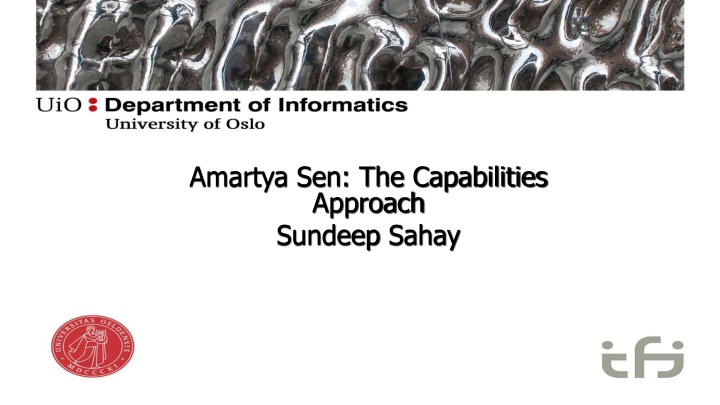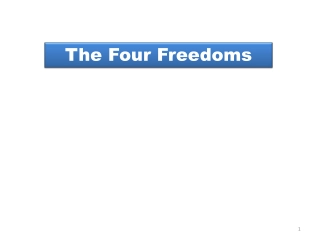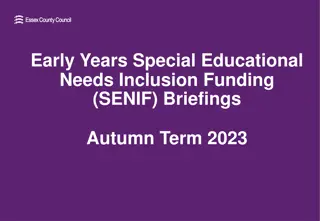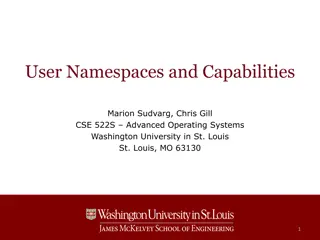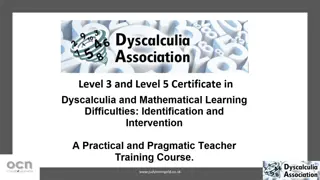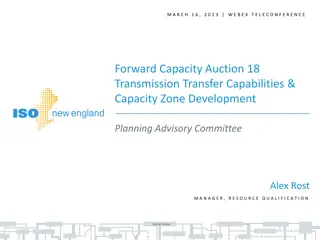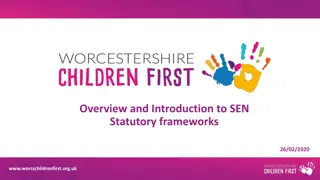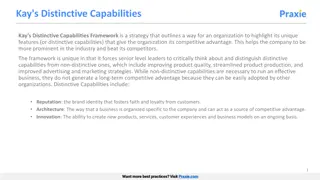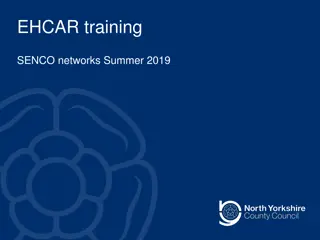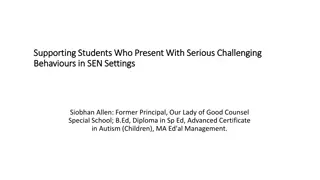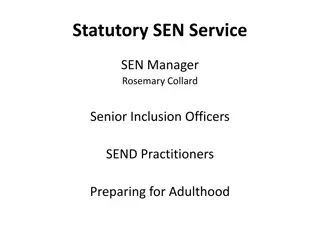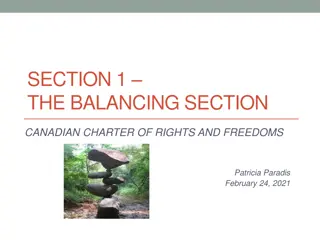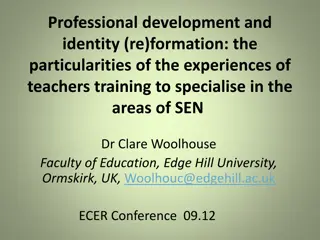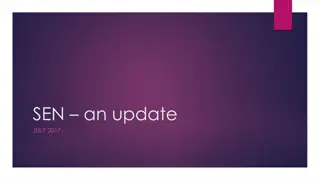The Capabilities Approach by Amartya Sen: Understanding Development and Freedoms
Amartya Sen's Capabilities Approach focuses on expanding people's real freedoms and choices to enhance development. It prompts debates on inequality measurement, role of institutions, and more. Sen identifies five types of freedoms essential for development, emphasizing the intrinsic and instrumental value of freedom. The approach distinguishes between means and ends of development, advocating for the removal of "unfreedoms" like poverty and social deprivation. Despite criticisms for abstraction, this interdisciplinary framework contributes to new development indicators and policy paradigms.
Download Presentation

Please find below an Image/Link to download the presentation.
The content on the website is provided AS IS for your information and personal use only. It may not be sold, licensed, or shared on other websites without obtaining consent from the author.If you encounter any issues during the download, it is possible that the publisher has removed the file from their server.
You are allowed to download the files provided on this website for personal or commercial use, subject to the condition that they are used lawfully. All files are the property of their respective owners.
The content on the website is provided AS IS for your information and personal use only. It may not be sold, licensed, or shared on other websites without obtaining consent from the author.
E N D
Presentation Transcript
Amartya Sen: The Capabilities Approach Sundeep Sahay
The paradox While ICTs are all pervasive in development projects, evidence of them creating positive development impacts are extremely limited A case in point is Health Information Systems, nearly no documented evidence of impacts on health outcomes
Amartya Sens Capability Approach Development can be seen as a process of expanding the real freedoms that people enjoy. [ ] Focusing particularly on people s capability to choose the lives they have reason to value (Sen 1999) Increasing choice
Contributions and criticisms Has prompted important debates on issues of measurement of inequality, capital, and savings, role of nonmarket institutions Does not provide a directly applicable and prescriptive tool kit on how to do it Provides an approach to a mode of thinking Criticized for being too abstract with challenges in its operationalization
Key focus On the expansion of people s freedoms Development focus to remove these unfreedoms - poverty, tyranny, poor economic opportunities, social deprivation, neglect of public facilities (schools and health), social intolerance. Providing enhanced possibilities for individuals to pursue choices that they value (Sen, 2001). Distinguishes between means and ends of development Highly interdisciplinary, resulting in new development indicators, and policy paradigm based on the human development approach
Types of freedoms Sen identified five instrumental freedoms: i) political freedoms, ii) economic facilities iii) social opportunities, iv) transparency guarantees v) protective security All relevant to the understanding of ICT4D Ends have intrinsic importance, whereas means are instrumental to reach the goals of development. Freedom has both intrinsic and instrumental value
Basic principles of Capabilities Approach (Sen 1992) - Functionings: The various things a person may value doing or being - Capabilities: the alternative functionings which an individual is able to achieve - Focus of development: to increase an individual s capabilities set - Choice is both the end and a principal means of development Too much emphasis on individual agency? Difficulty of operationalising the approach
Capabilities and functionings A functioning is an achievement, whereas a capability is the ability to achieve. Functionings are, in a sense, more directly related to living conditions, since they are different aspects of living conditions. Capabilities, in contrast, are notions of freedom, in the positive sense: what real opportunities you have regarding the life you may lead (Sen 1987: 36).
Conversion factors Resources (marketable goods and services) have characteristics that make them of interest to people, the bicyle example The relation between a good or a resource and the achievement of certain things with it represents a conversion factor : the degree to which a person can transform a resource into a functioning, and the skills needed to enable this transformation
Types of conversion factors Personal conversion factors Social conversion factors Environmental conversion factors For example, how much a bicycle contributes to a person's mobility depends on their physical condition (personal conversion factor), the social norms, for example whether women are socially allowed to ride a bicycle (social conversion factor), and the availability of decent roads or bike paths (environmental conversion factors) to enable effective use of the bike
Core aspects of Capability Approach Not utility focus Not resource focus Freedom focus: poverty is capability-deprivation Pluralistic in nature Focus on the individual and their agencies Encourages diversity
Agent Someone who acts and brings about change, whose achievement can be evaluated in terms of his or her own values and objectives. Includes both the intention and actual actions Concerns for: - Participation - Public debate in the public sphere - Democratic practice - Empowerment
Core aspects Real freedoms central There are individual differences in the ability to transform resources into valuable activities Convert capabilities to functionings Different activities can give rise to happiness importance of materialistic and nonmaterialistic factors Concern for the distribution of opportunities within society
Nussbaums list of capabilities 1) Life 2) Bodily Health 3) Bodily Integrity 4) Senses, Imagination, and Thought 5) Emotions 6) Practical Reason 7) Affiliation 8) Other Species. 9) Play. 10) Control over one's Environment. Capabilities not apriori determined from above. Need to be articulated by those whose freedom is at stake
Empowerment Expansion of agency: key components Agency Power and choice Participation Empowerment is a relational concept, where empowerment of one may contribute to disempowerment of others to whom the person is related Power relations are inherent in shaping empowerment, as enhancing ability to make a choice , implies that this ability was previously denied & involves changing existing power dynamics
Core aspects Real freedoms central There are individual differences in the ability to transform resources into valuable activities Convert capabilities to functionings Different activities can give rise to happiness importance of materialistic and nonmaterialistic factors Concern for the distribution of opportunities within society
The process of empowerment (Alsop & Heinsohn 2005) Agency Degree of Empowerment Development Outcomes Opportunity Structure
The sustainable livelihood framework (DFID 1999)
The Choice Framework STRUCTURE institutions and organisations discourses policies and programmes formal and informal laws including: - Norms on usage of space - Norms on usage of time technologies and innovations including: access to ICTs - availability of ICTs - affordability of ICTs - skills needed for ICTs DEVELOPMENT OUTCOMES ACHIEVED FUNCTIONINGS Primary: Choice DEGREES OF EMPOWERMENT Secondary, as chosen by individual, e.g.: CAPABILITIES existence of choice easier communication increased knowledge sense of choice better/more social relationships use of choice healthy environment achievement of choice increased income increased mobility AGENCY more voice SR more autonomy He CR etc. Age NR ER Gender Ethnicity PsR MR etc. Key: ER = Educational Resources SR = Social Resources PsR = Psychological Resources NR = Natural Resources In = Information MR = Material Resources FR = Financial Resources GR = Geographical Resources CR = Cultural Resources He = Health Ti = Time GR In (Kleine 2007, 2011, based on Alsop & Heinsohn 2005, DFID 1999) Ti FR
Capabilities Approach allows for.. Use of a systemic and holistic approach Further strive to operationalise the capability approach Resist the controllability myth Seeking out mechanisms to allow people to express choice, e.g. participatory monitoring and evaluation voucher schemes participatory budgets participatory procurement participatory tracking & tracing
Critical Capabilities Approach Critical Theory Sen s Capability Approach Expansion of freedom, or removal of unfreedoms that restrict individuals from exercising their reasoned agency; Emancipation, or removal of injustice, alienation and domination. Aspiration Sensitive to diversity of and discrepancies in human conditions; questions what conversion factors are in place to generate potentials to achieve, and to allow people the freedom of choice to realize the achievement; Special attention is given to those individuals who are oppressed or alienated. These are usually those who are least able to defend themselves and lack political and social power and representation Human Diversity Central to the capability approach, together with the concept of well-being, agency forms the basis of addressing deprivation; embedded in socio-cultural conditions; Emphasis on the effect of social structures on individual agency, especially through reification, hegemony of ideology; Individual Agency Regarded as commodities, i.e. goods and resources, meaningful only in terms of their contribution to people s capabilities; means rather than ends; Highlights ideological qualities and hegemonic functions of technology; sensitive to flexibility of technology and its role in distribution of power; Technology 22
Four principles of the CCA The principle of human-centered development; The principle of human diversity; The principle of protecting human agency; The principle of democratic discourses; 23
The Principle of Human-Centred Development Who defines openness and sets standards for open development? What are the driving forces for openness? Whose interests does openness promote? Should there be boundaries for openness and if so, where and how should they be drawn? Could openness become hegemonic, and if so, who will lose out? 24
The Principle of Human Diversity What capabilities does openness contribute? Under which circumstances? What are the enabling factors and what are the barriers? Depending on the definition of development in open development, who should be the preferred beneficiaries? What are the necessary social and institutional arrangements for openness to truly bring benefits? How do we ensure social inclusion in open development? How do we address issues of unfavorable inclusion in openness? 25
The Principle of Human-Centred Development Who defines openness and sets standards for open development? What are the driving forces for openness? Whose interests does openness promote? Should there be boundaries for openness and if so, where and how should they be drawn? Could openness become hegemonic, and if so, who will lose out? 26
The Principle of Protecting Human Agency Whose cultural assumptions are written into openness as a discourse? To what extent does openness enhance or undermine users autonomy and choices in life? Should users always be given the possibility to opt out of openness without being significantly disadvantaged? What might be the implications if openness become reified and taken for granted? 27
The Principle of Democratic Discourse Is any form of regulation of open development desirable? Which democratic structures would be required to make decisions about open development? How do we evaluate open development and how to structure democratic discussions about it? Who are the stakeholders and how do we involve them in the discussions? 28
